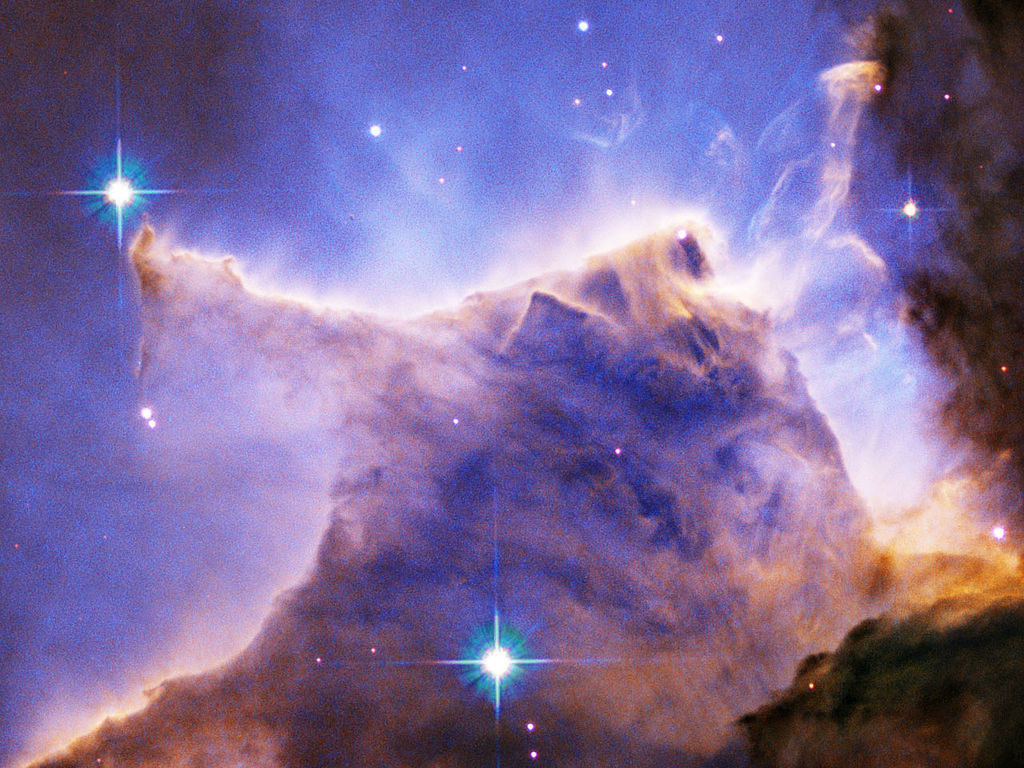Messier 16 (M16), the famous Eagle Nebula, is a star-forming nebula with a young open star cluster located in Serpens. M16 lies near the borders with the constellations Sagittarius and Scutum. The nebula is best known for the Pillars of Creation region, three large pillars of gas famously photographed by Hubble in 1995.
Also known as the Star Queen Nebula, M16 lies at a distance of 7,000 light years from Earth and has an apparent magnitude of 6.0. The cluster’s designation in the New General Catalogue is NGC 6611, while the nebula is referred to as IC 4703.
The Eagle Nebula occupies an area 70 by 55 light years in size, or 30 arc minutes of the sky, while the open cluster has a radius of 15 light years, corresponding to 7 arc minutes in angular diameter.
The name Eagle comes from the nebula’s shape, which is said to resemble an eagle with outstretched wings. American astronomer Robert Burnham, Jr. introduced the name Star Queen Nebula because the nebula’s central pillar reminded him of a silhouette of the Star Queen.
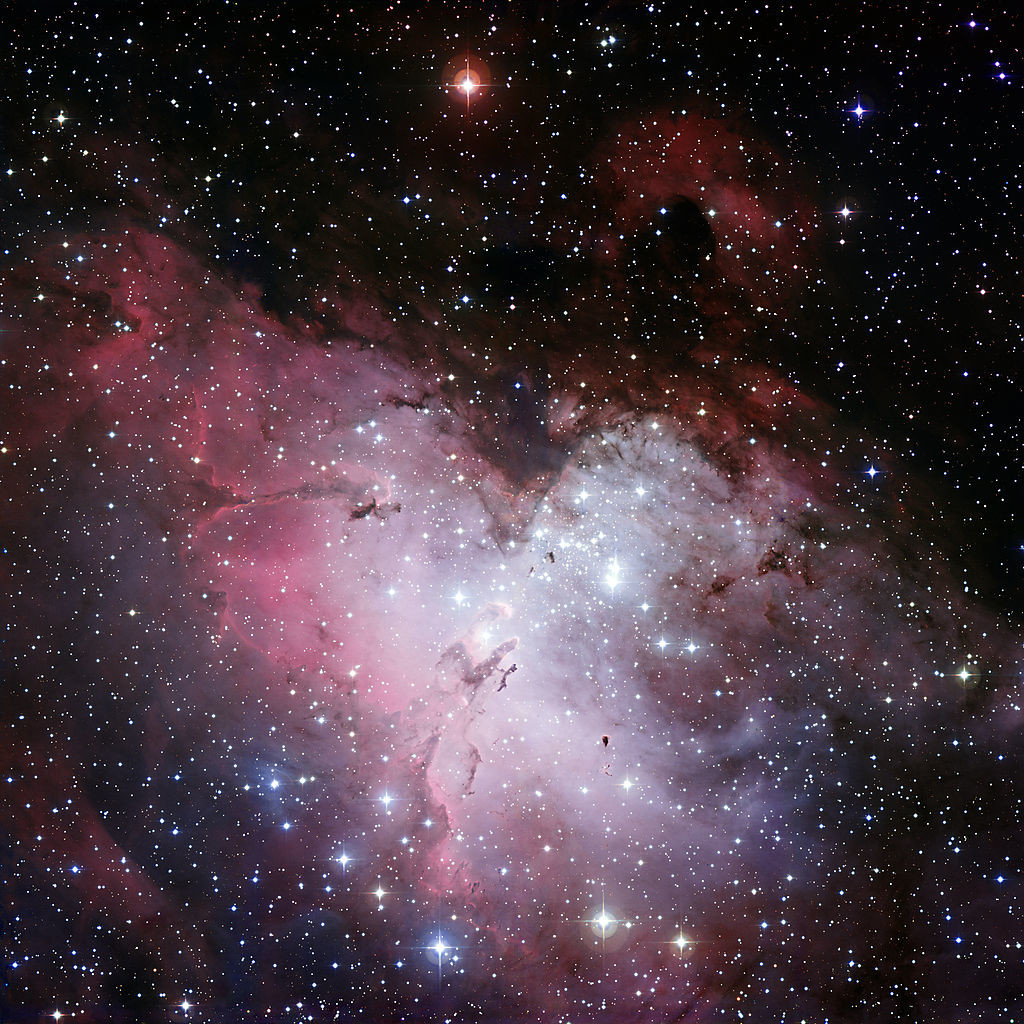
IC 4703, the H II region that surrounds the open cluster, is a diffuse emission nebula, a vast region of active star formation with a visual magnitude of 8, located in the Sagittarius Arm of the Milky Way Galaxy, the next inner spiral arm from our own.
Messier 16 is home to several regions of active star formation. These include the famous Pillars of Creation in the central part of the nebula and the Stellar Spire, located just to the left of the pillar structure.
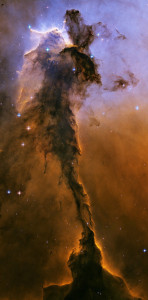
The largest of the three Pillars of Creation is approximately 4 light years high. The Stellar Spire, a large tower of gas that appears to be coming off the region of nebulosity, is about 9.5 light years high, corresponding to a length of 90 trillion kilometres. This is roughly twice the distance from the Sun to the nearest star system, Alpha Centauri.
The Stellar Spire is being eroded by the ultraviolet light of the young, massive, extremely hot stars seen at the top of the image. The stars are also responsible for illuminating the surface of the spire.
The Eagle Nebula is easy to find in the sky. It is located about 2.5 degrees west of the naked eye star Gamma Scuti in the constellation Scutum and a few degrees north of Messier 17, the Omega Nebula, in Sagittarius.
Gamma Scuti, a white giant with a visual magnitude of 4.70, lies along the imaginary line drawn from Altair, the brightest star in Aquila, down the eagle’s back to Lambda Aquilae, in the direction of Sagittarius. M16 is located at the southern tip of Serpens Cauda, the Serpent’s Tail, the eastern part of the constellation. (The constellation Serpens is divided into two separate sections – Serpens Caput or the Serpent’s Head and Serpens Cauda or the Serpent’s Tail – lying on each side of Ophiuchus, the Serpent Bearer.)
Messier 16 can also be found using the Teapot in Sagittarius. It is located along the line drawn from Kaus Australis to Kaus Media.
Messier 16 is best seen in a low powered telescope. 4-inch instruments will resolve about 20 stars against several regions of nebulosity. The star cluster is quite easy to find, but the surrounding nebulosity requires extremely good viewing conditions and large aperture instruments. The Pillars of Creation can only be seen in 12-inch and larger telescopes.
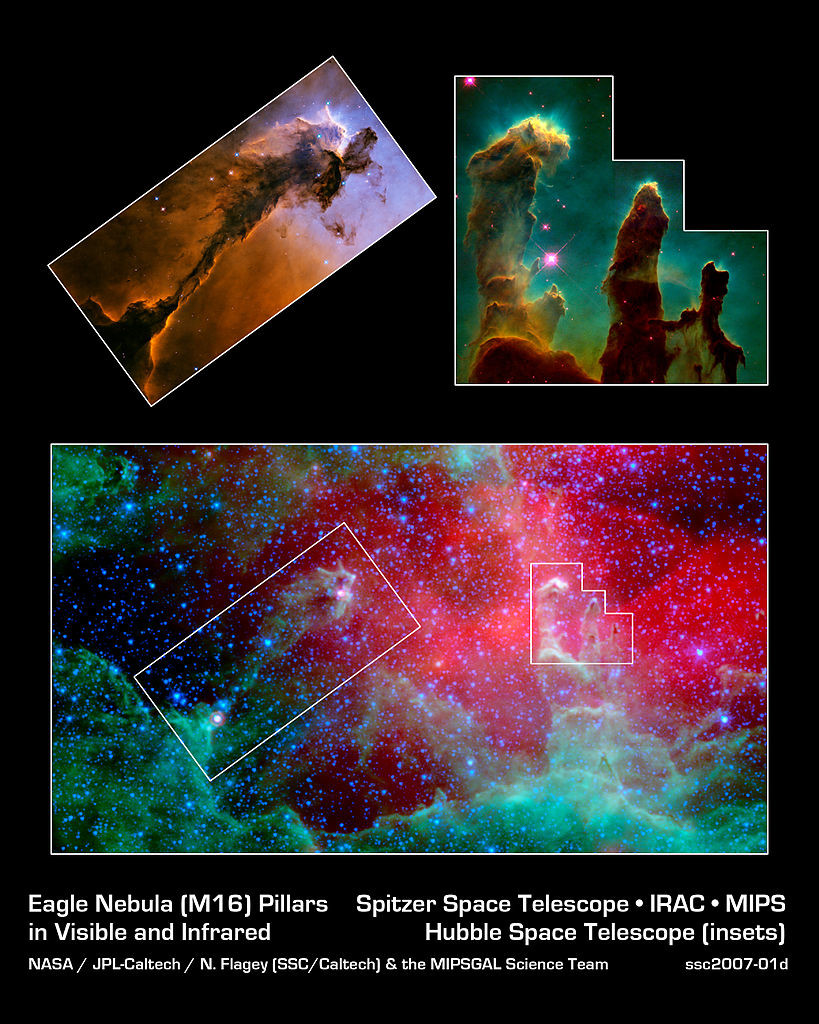
In both cases, Spitzer’s view exposes newborn stars that were hidden inside the cocoon-like pillars, invisible to Hubble. These stars were first uncovered by the European Space Agency’s Infrared Satellite Observatory. In the Spitzer image, two embedded stars are visible at the tip and the base of the left pillar, while one star can be seen at the tip of the tallest pillar on the right. Image: NASA/JPL-Caltech/N. Flagey (IAS/SSC) & A. Noriega-Crespo (SSC/Caltech)
The best time of year to see Messier 16 from northern latitudes is summer, when Serpens and Sagittarius can be seen above the horizon in the southern sky after sunset.
There are several other Messier objects in the same field of view, just above the Teapot: Messier 17 (the Omega Nebula), the open cluster Messier 18, Messier 20 (the Trifid Nebula), the open star clusters Messier 21, Messier 23 and Messier 25, Messier 8 (the Lagoon Nebula), and the globular clusters Messier 22 and Messier 28.
The brightest star in the Eagle Nebula, catalogued as HD 168076, can easily be seen in binoculars. It is really a binary star system composed of an O3.5V star and an O7.5 companion. The system has an apparent magnitude of 8.24.
The open cluster NGC 6611 contains about 460 stars. The brightest members are only 1 to 2 million years old and belong the spectral class O. These young stars are about 80 times as massive as the Sun and up to 1 million times more luminous. NGC 6611 was classified by Shapley as a type ‘c’ cluster, which means that it is very loose and irregular.
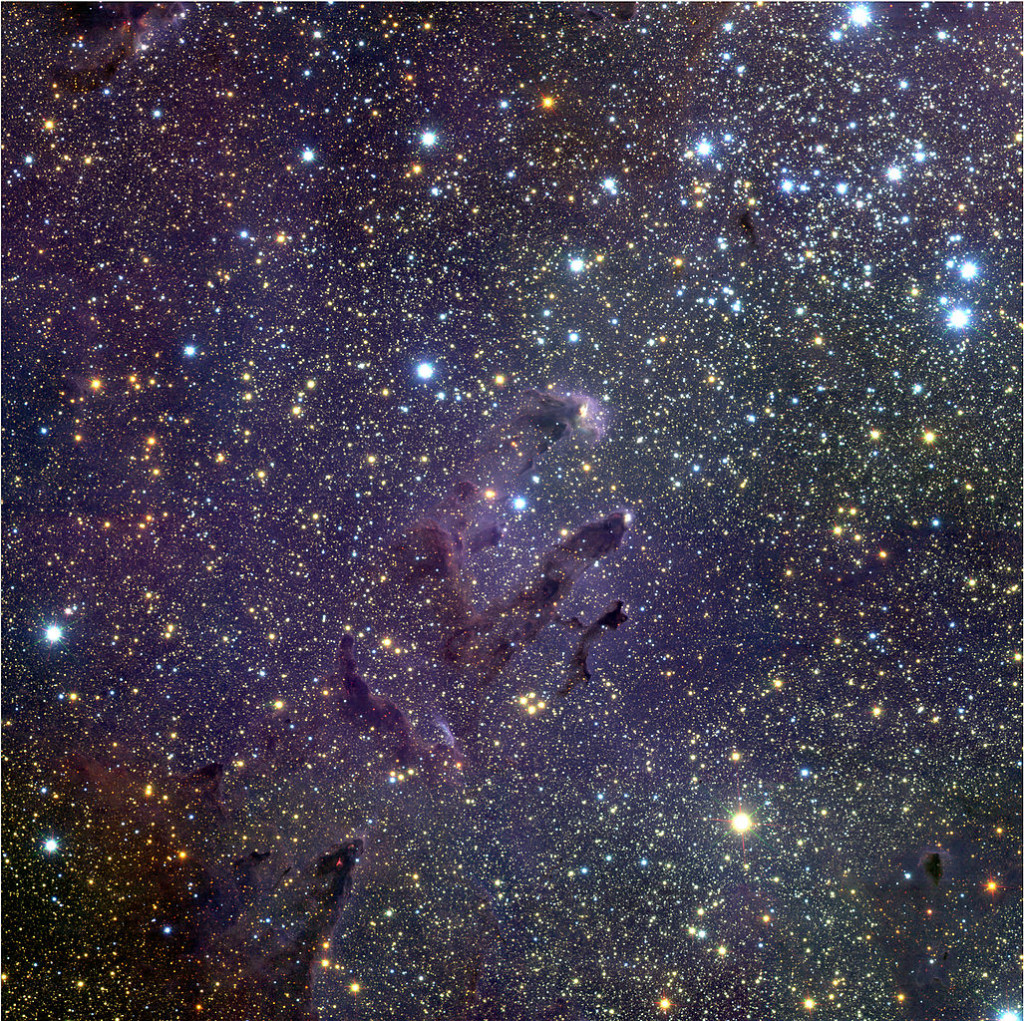
This photo is the result of a three-colour composite mosaic image of the Eagle Nebula (Messier 16), based on 144 individual images obtained with the infrared multi-mode instrument ISAAC on the ESO Very Large Telescope (VLT) at the Paranal Observatory. At the centre, the so-called “Pillars of Creation” can be seen. This wide-field infrared image shows not only the central three pillars but also several others in the same star-forming region, as well as a huge number of stars in front of, in, or behind the Eagle Nebula. The cluster of bright blue stars to the upper right is NGC 6611, home to the massive and hot stars that illuminate the pillars. Image: ESO
Messier 16 was discovered by the Swiss astronomer Jean-Philippe Loys de Chéseaux in 1745-46. He described the object as a “star cluster between the constellations of Ophiuchus, Sagittarius, and Antinous [now Scutum], of which RA is 271d 3′ 10″ and southern declination is 13d 47′ 20″.”
The nebula itself was discovered by Charles Messier on June 3, 1764. Messier described a “cluster of small stars, enmeshed in a faint glow, near the tail of Serpens, at little distance to the parallel of Zeta of this constellation; with an inferior telescope this cluster appears like a nebula. “
In his entry in the first Messier catalogue (1771), he wrote:
In the same night of June 3 to 4, 1764, I have discovered a cluster of small stars, mixed with a faint light, near the tail of Serpens, at little distance from the parallel of the star Zeta of that constellation: this cluster may have 8 minutes of arc in extension: with a weak refractor, these stars appear in the form of a nebula; but when employing a good instrument one distinguishes these stars, & one remarkes in addition a nebulosity which contains three of these stars. I have determined the position of the middle of this cluster; its right ascension was 271d 15′ 3″, & its declination 13d 51′ 44″ south.
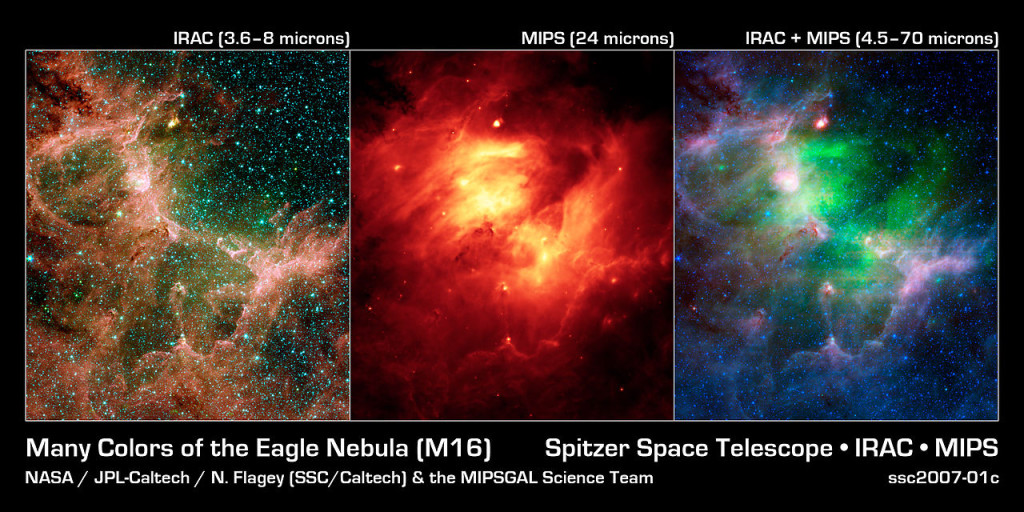
The left image is a composite of infrared light with the following wavelengths: 3.6 microns (blue); 4.5 microns (green); 5.8 microns (orange); and 8 microns (red). The right image includes longer infrared wavelengths, and is a composite of light of 4.5 to 8.0 microns (blue); 24 microns (green); and 70 microns (red). The middle image is made up solely of 24-micron light. Image: NASA/JPL-Caltech/N. Flagey (IAS/SSC) & A. Noriega-Crespo (SSC/Caltech)
William Herschel observed the cluster on July 30, 1783 and noted, “Large stars with small ones among them; within a small compass I counted more than 50, and there must be at least 100 without taking in a number of straggling ones, everywhere dispersed in the neighborhood.”
Admiral William Henry Smyth, who observed the nebula in July 1835, wrote:
A scattered but fine large stellar cluster, on the nombril of Sobieski’s shield [Scutum], in the Galaxy, discovered by Messier in 1764, and registered as a mass of small stars in the midst of a faint light. As the stars are disposed in numerous pairs among the evenescent points of more minute components, it forms a very pretty object in a telescope of tolerable capacity. Its mean apparent place was obtained by differentiation with the equatorial instrument upon Mu Sagittarii, from which it lies north-half-east, at 7 deg distance; where it is on the line produced between Theta Ophiuchi and Delta Aquilae, which also reaches Altair.
In 1895, the American astronomer Edward Emerson Barnard was the first to produce a photograph of the nebula, and it was the image taken by amateur astronomer and astrophotography pioneer Isaac Roberts in 1897 that brought the Eagle Nebula into the IC catalogue of 1908.
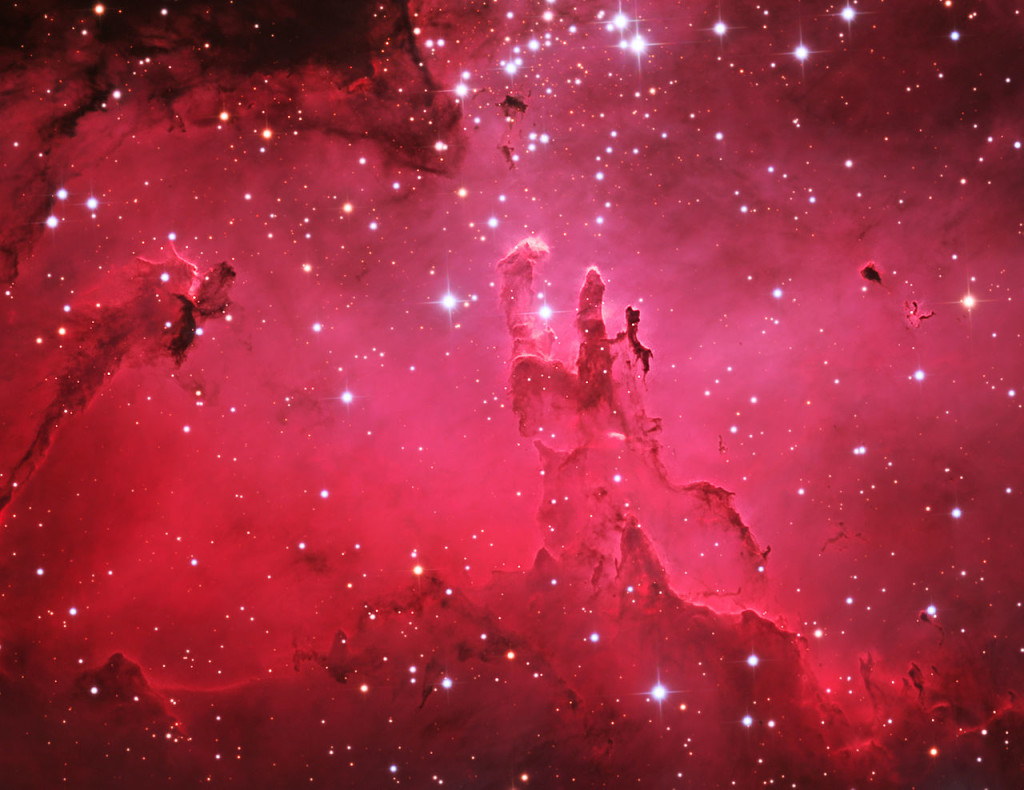
FACTS
| Object: Emission nebula with an open cluster |
| Designations: Eagle Nebula, Messier 16, M16, NGC 6611, IC 4703, Star Queen Nebula, The Spire, Sharpless 49, RCW 165, Gum 83, Collinder 375, C 1816-138, CTB 51 |
| Features: Pillars of Creation, Stellar Spire |
| Constellation: Serpens |
| Right ascension: 18h 18m 48s |
| Declination: -13°49′ |
| Distance: 7,000 light years (2,146 parsecs) |
| Age: 5.5 million years |
| Apparent magnitude: +6.0 |
| Absolute magnitude: -8.21 |
| Apparent dimensions: 30′ (nebula), 7′ (cluster) |
| Radius: 70×55 light years (nebula), 15 light years (cluster) |
LOCATION
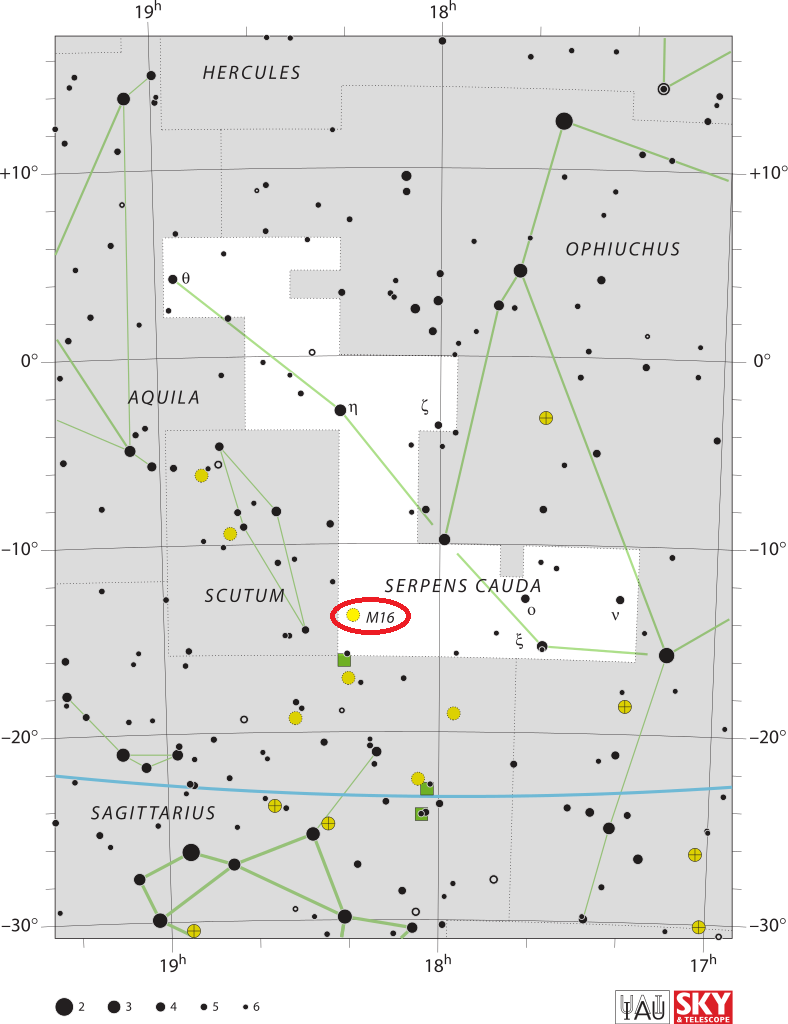
IMAGES
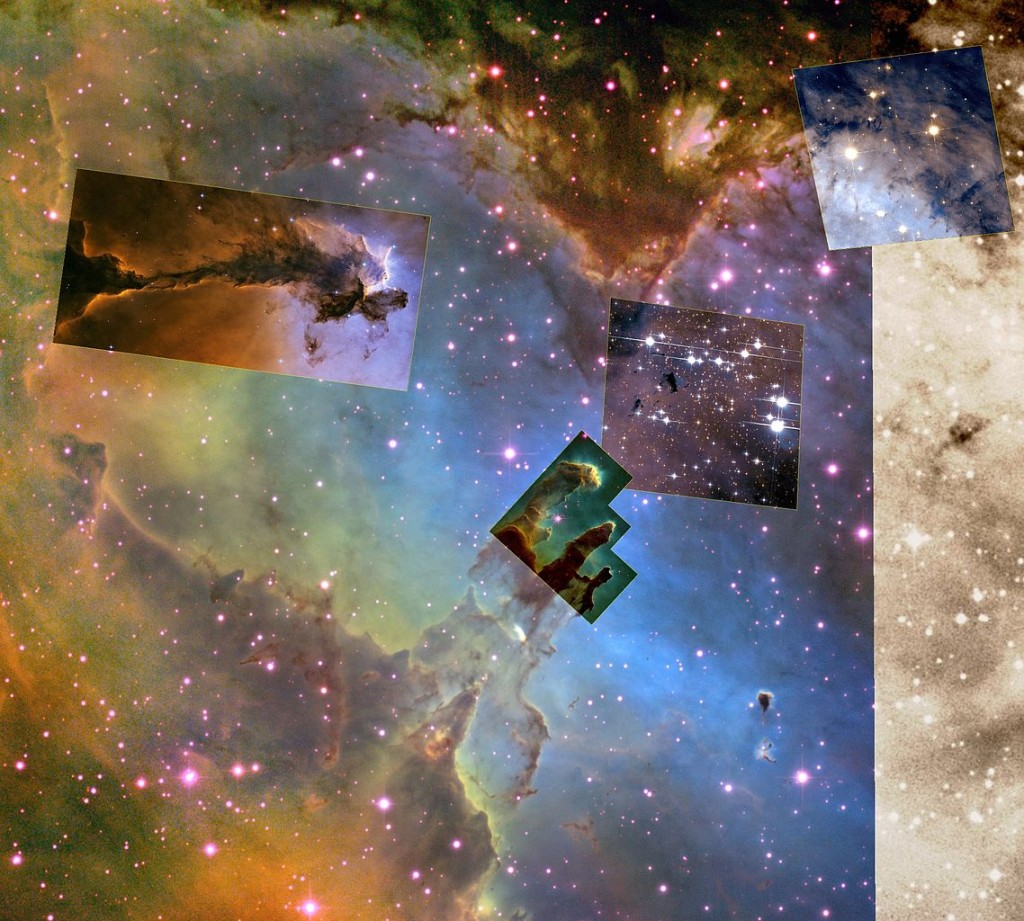
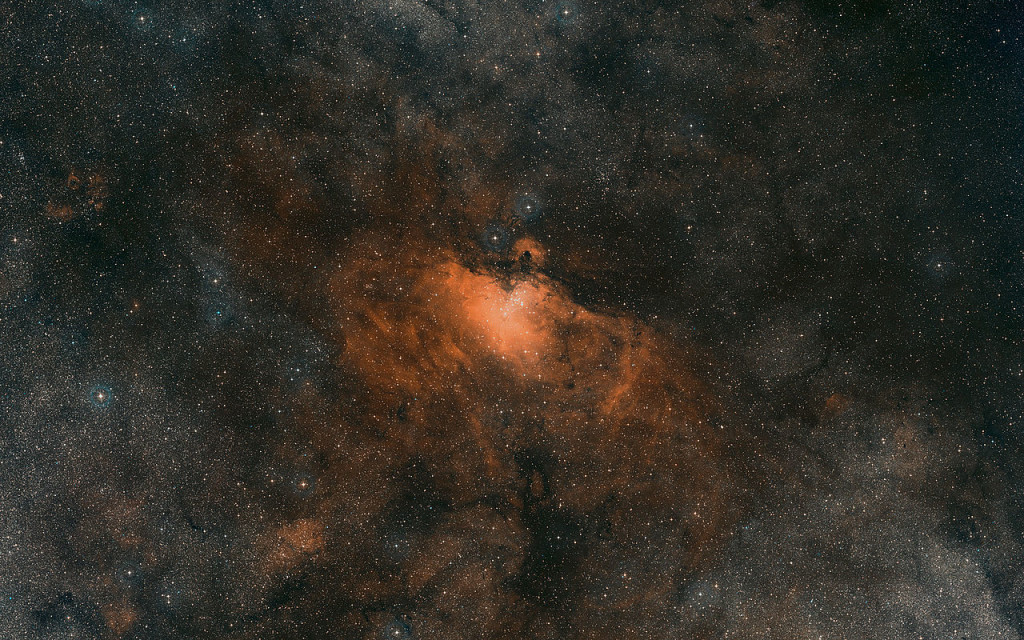
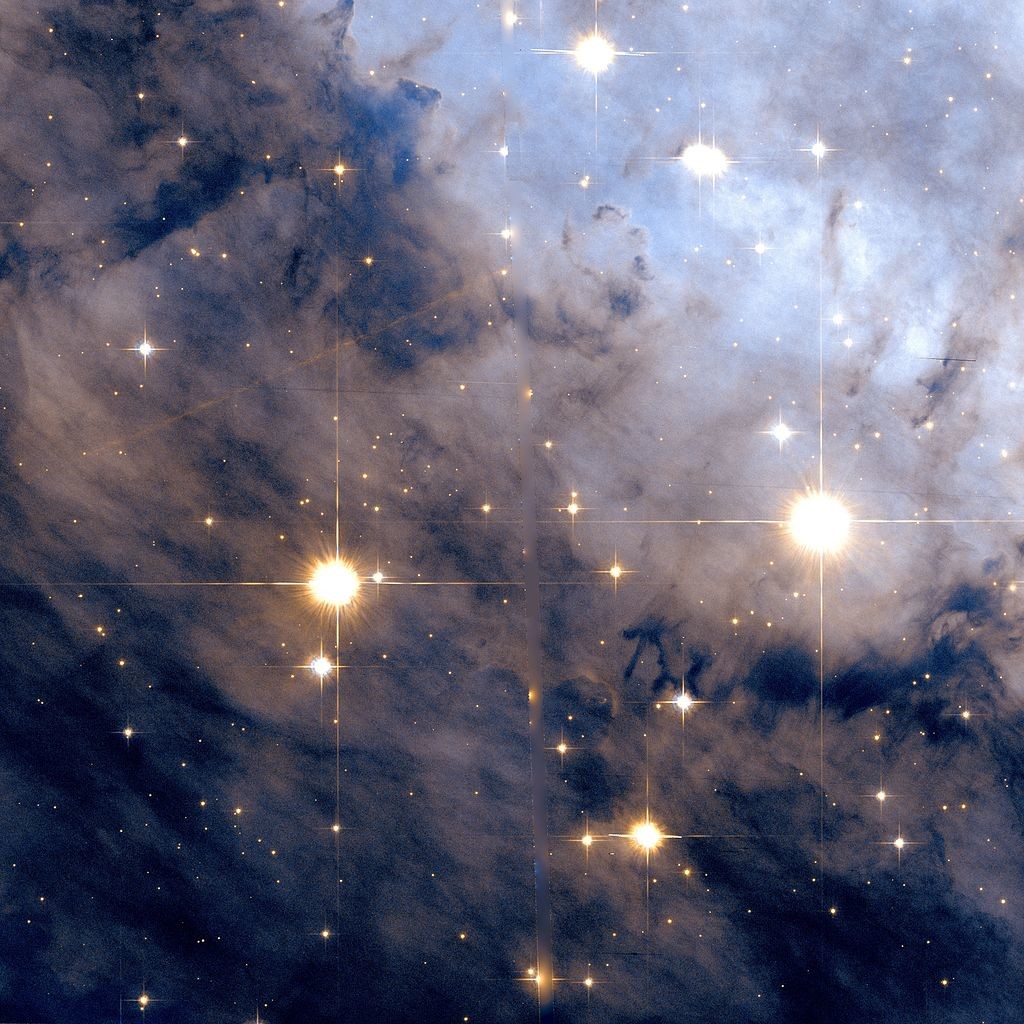
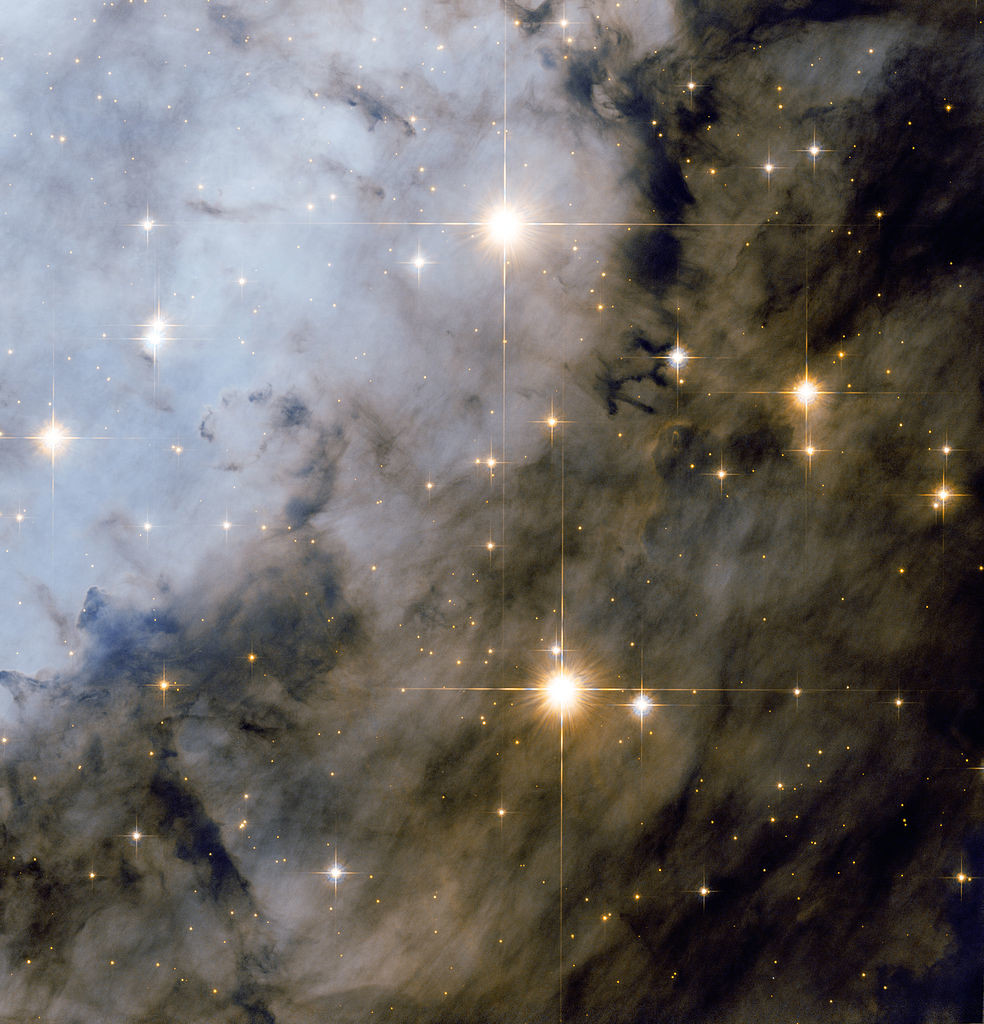
The cluster and nebula are fascinating targets for small and medium-sized telescopes, particularly from a dark site free from light pollution. Messier 16 can be found within the constellation of Serpens Cauda (the Tail of the Serpent), which is sandwiched between Aquila, Sagittarius, and Ophiuchus in the heart of one of the brightest parts of the Milky Way. Small telescopes with low power are useful for observing large, but faint, swathes of the nebula, whereas 30 cm telescopes and larger may reveal the dark pillars under good conditions. But a space telescope in orbit around the Earth, like Hubble — which boasts a 2.4-metre diameter mirror and state-of-the-art instruments — is required for an image as spectacular as this one.
This picture was created from images taken with the Wide Field Channel of Hubble’s Advanced Camera for Surveys. Images through a near-infrared filter (F775W) are coloured red and images through a blue filter (F475W) are blue. The exposures times were one hour and 54 minutes respectively and the field of view is about 3.3 arcminutes across. Image: ESA/Hubble & NASA
